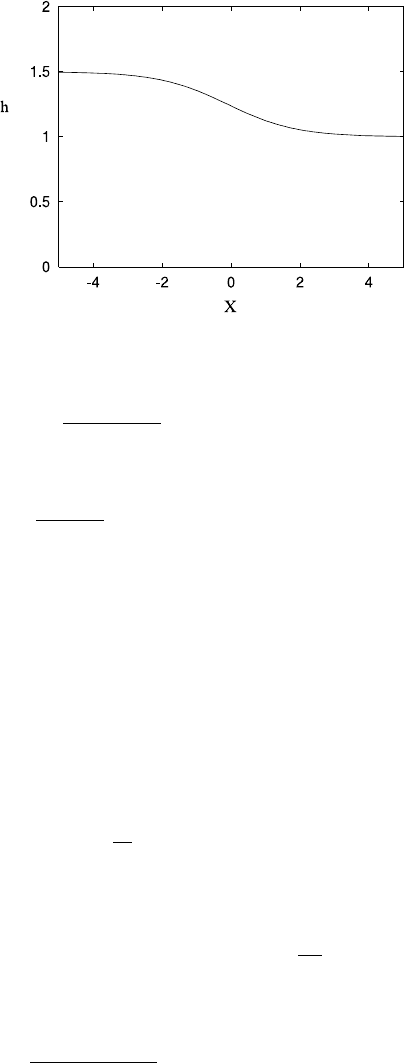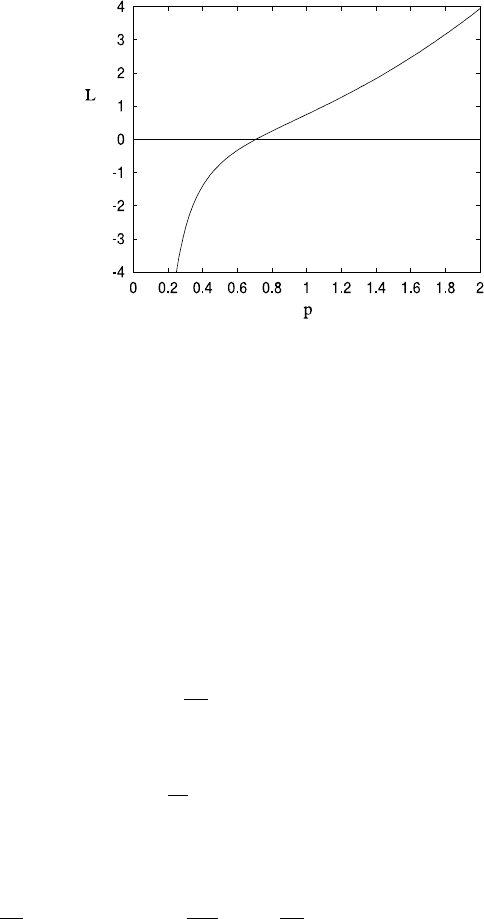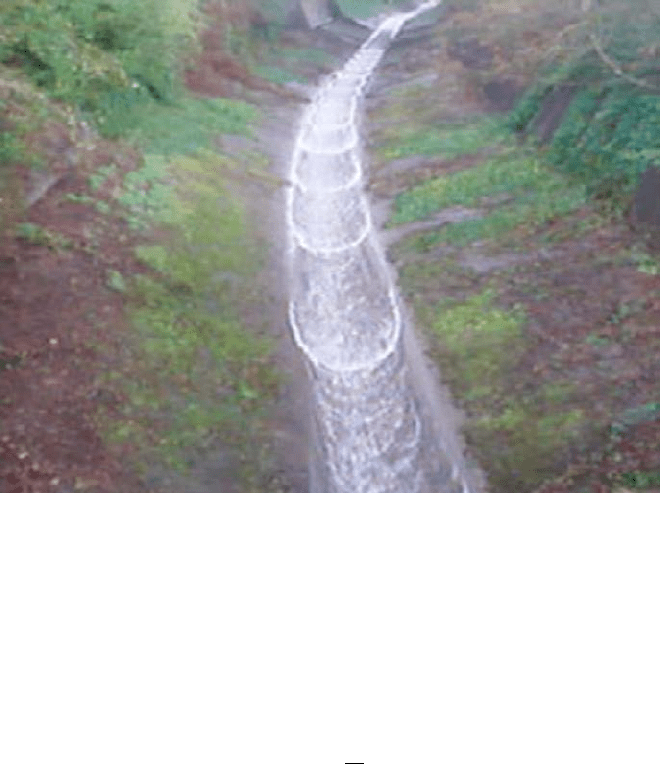Fowler A. Mathematical Geoscience
Подождите немного. Документ загружается.


230 4 River Flow
4.4 St. Venant Equations
We now re-examine the momentum equation, which we previously assumed to be
described by a force balance. Again consider the equations in dimensional form. For
the remainder of the chapter we take M =0, largely for simplicity. Conservation of
mass can then be written in the form
∂A
∂t
+
∂
∂s
(Au) = 0, (4.41)
where the mean velocity u is defined by
u =
Q
A
, (4.42)
and then conservation of momentum (from first principles) leads to the equation
(adopting the friction law (4.9))
ρ
∂(Au)
∂t
+ρ
∂
∂s
Au
2
=ρgAS −ρlf u
2
−
∂
∂s
(A ¯p), (4.43)
where ¯p is the mean pressure. Now the pressure is approximately hydrostatic, thus
p ≈ ρgz where z is depth. Then ¯pA ≈
1
2
ρgh
2
dx where h is total depth and x is
width, and thus
∂
∂s
(A ¯p) =ρg
A
∂h
∂s
dA; (4.44)
if we suppose ∂h/∂s is independent of x, we find
2
∂
∂s
(A ¯p) =ρgA
∂
¯
h
∂s
, (4.45)
where
¯
h is the mean depth. Using (4.41), (4.43) reduces to
u
t
+uu
s
=gS −
flu
2
A
−g
∂
¯
h
∂s
. (4.46)
Equations (4.41) and (4.46) are known as the St. Venant equations.
3
2
The assumption that ∂h/∂s is constant across the stream means that along a transverse section
of the river, the surface is horizontal. This is really due to the smallness of the width compared
to the length. It is importantly not exactly true for meandering rivers, but is still a very good
approximation.
3
Note that the derivation of (4.46) assumes a constant slope S. If the slope is varying, then the
derivation is still valid providing S is the local bed slope. If we then take
¯
S to be the average
downstream slope, and denote the bed by z =b(s) and the surface by z = η(s), we have the local
slope S =
¯
S − b
s
, and thus S −h
s
=
¯
S − η
s
, and thus (4.46) still applies for varying bed slope
when S denotes the (constant) mean slope, providing we replace
¯
h by η. All of this supposes that
b does not vary with x, i.e., the channel section is rectangular.

4.4 St. Venant Equations 231
4.4.1 Non-dimensionalisation
We choose scales for u =Q/A, t, s, A, R (the hydraulic radius, = A/l) and
¯
h as
follows, in keeping with the assumed balances adopted earlier:
Au ∼Q, gS ∼
lf u
2
A
=
fu
2
R
,
t ∼
s
u
,s∼
d
S
,
¯
h, R ∼d,
(4.47)
where we can suppose Q is a typical observed discharge, and d is a typical observed
depth. Explicitly, the scales are
[
¯
h], [R]=d, [s]=
d
S
,
[u]=
gdS
f
1/2
, [t]=
fd
gS
3
1/2
, [A]=Q
f
gdS
1/2
,
(4.48)
and we put u =[u]u
∗
, etc., and drop asterisks. The resulting equations are
A
t
+(Au)
s
=0,
F
2
[u
t
+uu
s
]=1 −
u
2
R
−h
s
,
(4.49)
where we would choose h ∼R ∼A for a wide channel, h ∼R ∼A
1/2
for a rounded
channel. In particular, for a wide channel, we have R = h, so that the momentum
equation can be written
(wh)
t
+(wuh)
s
=0,
F
2
(u
t
+uu
s
) =1 −
u
2
h
−h
s
,
(4.50)
since A =wh, where w is the (dimensionless) width. As before, the Froude number
F is given by
F =
[u]
(gd)
1/2
=
S
f
1/2
. (4.51)
4.4.2 Long Wave and Short Wave Approximation
To estimate some of these scales, we take d = 2m,u = 1ms
−1
and S = sinα =
0.001, typical lowland valley values. We then have the length scale [s]=
d
S
∼2km,
and the time scale t ∼ 33 minutes, and in some sense these are the natural length
and time scales for the dynamic river response. However, it is fairly clear that these
scales are not appropriate either for variations over the length of a whole river, or for
the shorter length and time scales appropriate to waves generated by passage of a
boat, for example. Both of these situations lead to further simplifications, as detailed
below.

232 4 River Flow
Long Wave Theory
Suppose we have a river of length L = 100 km, and we are concerned with the
passage of a flood wave along its length. It is then appropriate to rescale s and t as
s ∼
1
ε
,t∼
1
ε
,ε=
d
H
,H=L sin α; (4.52)
note that H is the drop in elevation of the river over its length L: in this instance
ε ∼0.02 1. In this case equations (4.50) become
h
t
+(uh)
s
=0,
εF
2
(u
t
+uu
s
) =1 −
u
2
h
−εh
s
,
(4.53)
and in the limit ε →0, we regain the slowly varying flow approximation.
Short Wave Theory
An alternative approximation is appropriate if length scales are much shorter than
2 km. This is often the case, and particularly in dynamically generated waves, as we
discuss further below. In this case, it is appropriate to rescale length and time as
s ∼δ, t ∼δ, δ =
H
d
, (4.54)
where now δ 1, and then the model equations (4.50) become
h
t
+(uh)
s
=0,
F
2
(u
t
+uu
s
) =δ
1 −
u
2
h
−h
s
,
(4.55)
and when δ is put to zero, we regain the shallow water equations of fluid dynamics.
4.4.3 The Monoclinal Flood Wave
One of the suggestions made at the end of Sect. 4.3 was that the shocks predicted by
the slowly varying flood wave theory would in reality be smoothed out by some
higher-order physical effect. This shock structure is called the monoclinal flood
wave (because it is a monotonic profile), and it can be understood in the context
of the long wave St. Venant theory (4.53). The simplest version is when F 1as
well as ε 1, for then we can approximate the momentum equation (4.53)
2
by the
relation
u ≈h
1/2
1 −
1
2
εh
s
...
, (4.56)

4.4 St. Venant Equations 233
and (4.53)
1
becomes
∂h
∂t
+
3
2
h
1/2
h
s
≈
1
2
ε
∂
∂s
h
3/2
∂h
∂s
. (4.57)
This is a convective diffusion equation much like Burgers’ equation, and we ex-
pect it to support a monoclinal wave which provides a shock structure joining values
h
−
upstream to lower values h
+
downstream. We analyse this shock structure by
writing
s =s
f
+εX, (4.58)
where s
f
is the flood wavefront, and X is a local coordinate within the shock struc-
ture. To leading order we then obtain the equation
−ch
X
+
h
3/2
1 −
1
2
h
X
X
=0, (4.59)
where c =˙s
f
is the wave speed. Integrating this, we obtain
ch =h
3/2
1 −
1
2
h
X
+K, (4.60)
where we require
K =ch
−
−h
3/2
−
=ch
+
−h
3/2
+
(4.61)
(which gives the shock speed determined in the usual way by the jump condition
c =[h
3/2
]
+
−
/[h]
+
−
). Hence h is given by the quadrature
2X =
h
0
h
h
3/2
dh
[ch −h
3/2
]−K
, (4.62)
where the arbitrary choice of h
0
∈(h
+
,h
−
) simply fixes the origin of X.(4.62) can
be simplified to give
X =
w
0
w
w
4
dw
(w −w
+
)(w
−
−w)(w +C)
, (4.63)
where w =h
1/2
, and
C =
w
+
w
−
w
+
+w
−
, (4.64)
and X(w) can of course be evaluated.
Of particular interest is the small flood limit, in which w =w
−
−w
+
is small.
In this case C ≈
1
2
w
+
, and h can be found explicitly, as the approximation
h =
h
1/2
+
+h
1/2
−
e
−X/X
1 +e
−X/X
2
, (4.65)
where
X =
2w
3
+
3w
=
4h
2
+
3h
(4.66)

234 4 River Flow
Fig. 4.4 The monoclinal
flood wave given by (4.65),
with h
−
=1.5, h
+
=1,
X =1
is the shock width. A further simplification (because h =h
−
−h
+
is small) is
h =h
+
+
h e
−X/X
1 +e
−X/X
. (4.67)
In dimensional terms, the shock width is of order
d
2
d sinα
, (4.68)
where d is the depth, and d is the change in depth. Following a storm, if a river of
depth two metres and bedslope 10
−3
rises by a foot (thirty centimetres), the shock
width is about thirteen kilometres: not very shock-like! Figure 4.4 shows the form
of the monoclinal flood wave (as given by (4.65)).
Although (4.57) is useful in indicating the diffusive structure of the long wave
theory, the above discussion of the monoclinal flood wave is strictly inaccurate,
since the approximation in (4.56) breaks down on short scales. To see that the anal-
ysis still holds, we can re-do the analysis on the full system (4.53). Adopting (4.58),
we find, approximately,
−ch
X
+(uh)
X
=0,
F
2
(−cu
X
+uu
X
) =1 −
u
2
h
−h
X
,
(4.69)
with first integral
ch =K +uh, (4.70)
with K and c determined by (4.61) as before, noting that u
±
=
√
h
±
, and thus
u
±
=w
±
,asusedin(4.63).
We then find that
h
X
=
h
3
−(ch −K)
2
h
3
−K
2
F
2
, (4.71)

4.4 St. Venant Equations 235
and (4.63) is replaced by
X =
h
0
h
(h
3
−K
2
F
2
)dh
(h −h
+
)(h
−
−h)(h −A)
, (4.72)
where
A =
K
2
h
−
h
+
=
w
+
w
−
w
+
+w
−
2
. (4.73)
Clearly A<h
−
,h
+
, and thus the flood wave connecting h
−
to h
+
as X increases
exists (with h
−
>h
+
) if the numerator in (4.72) is positive for all h>h
+
, which is
the case, using the definition of
K =
h
+
h
−
√
h
+
+
√
h
−
, (4.74)
if
F<
h
+
h
−
+
h
+
h
−
. (4.75)
Since h
−
>h
+
, the upper limit of the right hand side is two, so that the monoclinal
flood wave cannot exist for F>2, consistent with the fact that roll waves then form,
as we now show.
4.4.4 Waves and Instability
The monoclinal flood wave is one example of a river wave. More generally, we
can expect disturbances to a uniformly flowing stream to cause waves to propagate,
and in this section we study such waves. In particular, we will find that if the basic
flow is sufficiently rapid, then disturbance waves will grow unstably. Such waves
are commonly seen in fast flowing rivulets, for example on steep pavements during
rainfall, and even on car windscreens.
To analyse waves on rivers, we take the basic river flow as being (locally) con-
stant, thus in (4.50) (with R =h)
u =h = 1, (4.76)
and we examine its stability by writing
u =1 +v, h =1 +H, (4.77)
and linearising. We obtain the linear system
H
t
+H
s
+v
s
=0,
F
2
(v
t
+v
s
) =−2v +H −H
s
,
(4.78)
whence
F
2
∂
∂t
+
∂
∂s
2
v =−2
∂
∂t
+
∂
∂s
v −v
s
+v
ss
. (4.79)

236 4 River Flow
Fig. 4.5 The function L(p)
defined by (4.85), with
˜
k =1
Solutions v = exp[iks +σt] exist, provided σ satisfies
F
2
(σ +ik)
2
+2(σ +ik) +ik +k
2
=0, (4.80)
or
˜σ =−i
˜
k −1 ±
1 −i
˜
k −
˜
k
2
/F
2
1/2
, (4.81)
where we write
σ =˜σ/F
2
,k=
˜
k/F
2
. (4.82)
There are thus two wave-like disturbances. The possibility of instability exists, if
either value of ˜σ has positive real part. We define the positive square root in (4.81)
to be that with positive real part. Specifically, we define
p +ikq =
1 −i
˜
k −
˜
k
2
F
2
1/2
, (4.83)
where we take p>0; thus, the real and imaginary parts of ˜σ are given by
˜σ
R
=±p −1, −
˜σ
I
˜
k
=1 ∓q, (4.84)
and the criterion for instability is that ˜σ
R
> 0, i.e., p>1. In this form, the growth
rate of the wave is ˜σ
R
/F
2
, while the wave speed is −˜σ
I
/
˜
k.From(4.83), we find
q =−
1
2p
,L(p)≡p
2
−
˜
k
2
4p
2
=1 −
˜
k
2
F
2
. (4.85)
As illustrated in Fig. 4.5, L(p) is a monotonically increasing function of p, and
therefore the instability criterion p>1 is equivalent to L(p) > L(1). Since p is
determined by L(p) =1 −(
˜
k
2
/F
2
), while from (4.85), L(1) =1 −(
˜
k
2
/4),wesee
that instability occurs if
F>F
c
=2. (4.86)

4.5 Nonlinear Waves 237
Thus, for tranquil flow, F<O(1), the flow is stable. For rapid flow, F>O(1),
it can be unstable. The wave which goes unstable (when p =1) propagates down-
stream, because its wave speed is 1 − q =
3
2
, and in fact the p>0 wave always
propagates downstream. The other wave, always stable, propagates downstream un-
less 1 +q<0, i.e., if and only if p<1/2, or equivalently,
F<F
−
=
2
˜
k
(3 +4
˜
k
2
)
1/2
. (4.87)
Note that F
−
depends on
˜
k, and that 0 <F
−
< 1. Rewriting this inequality in terms
of F and k,itis
F
2
1 −F
2
>
3
4k
2
, (4.88)
and upstream propagating waves are possible for short waves with k>
√
3.
We therefore have three distinct ranges for F :
F>2: two waves downstream, one unstable;
1 <F <2: two waves downstream, both stable;
F<1: stable waves can propagate upstream and downstream.
To go further than this requires a study of the nonlinear system (4.49). We see that
the transition at F =1 is associated with the ability of waves to propagate upstream.
The transition at F =2 is sometimes called a Vedernikov instability and is associ-
ated with the formation of downstream propagating roll waves.
4.5 Nonlinear Waves
When F>2, linear disturbances will grow, and nonlinear effects become important
in limiting their eventual amplitude. Because of the hyperbolic form of the equa-
tions, we might then expect shocks to form. To examine this hyperbolic form, we
put
γ =
1
F
. (4.89)
The equations are then
h
t
+(hu)
s
=0,
u
t
+uu
s
+γ
2
h
s
=γ
2
1 −
u
2
h
,
(4.90)
and they can be written in the form
∂
∂t
h
u
+
uh
γ
2
u
∂
∂s
h
u
=
0
γ
2
[1 −
u
2
h
]
. (4.91)

238 4 River Flow
4.5.1 Characteristics
The analysis of characteristics for systems of hyperbolic equations is described in
Chap. 1. The eigenvalues of B =
uh
γ
2
u
are given by
λ =u ±γh
1/2
, (4.92)
and the matrix P of eigenvectors and its inverse P
−1
are given by
P =
√
h
√
h
γ −γ
,P
−1
=
1
2γ
√
h
γ
√
h
γ −
√
h
. (4.93)
Comparing this with (1.69), we see that the integral
P
−1
du =
dh
2
√
h
+
du
2γ
dh
2
√
h
−
du
2γ
=
√
h +
u
2γ
√
h −
u
2γ
(4.94)
is well-defined, and determines the characteristic variables (the Riemann invariants,
so called because they are constant on the characteristics in the absence of the forc-
ing gravity and friction terms, as in shallow water theory). The equations can thus
be compactly written in the characteristic form
∂
∂t
+
u ±γ
√
h
∂
∂s
u ±2γ
√
h
=γ
2
1 −
u
2
h
. (4.95)
Nonlinear waves propagate downstream if u/γ h
1/2
> 1, but one will propagate up-
stream if u/γ h
1/2
< 1. This is consistent with the preceding linear theory (since
u/γ h
1/2
is the local Froude number, i.e., the Froude number based on the local val-
ues of velocity and depth). Because Eqs. (4.95) are of second order, simple shock
wave formation analysis is not generally possible. Equations (4.95) are very similar
to those of gas dynamics, or the shallow water equations, and the equations support
the existence of propagating shocks in a similar way.
4.5.2 Roll Waves
There is a good deal of evidence that solutions of (4.90) do indeed form shocks,
and when these are formed via the instability when F>2, the resultant waves are
called roll waves. They are seen in steep flows with relatively smooth beds (and
thus low friction), but this combination is difficult to find in natural rivers. It is
found, however, in artificial spillways, such as that shown in Fig. 4.6, which shows
a photograph of roll waves propagating down a spillway in Canada. Roll waves
can be found forming on any steep incline. Film flow down steep slopes during
heavy rainfall will inevitably form a sequence of periodic waves, and these are also
roll waves; see Fig. 4.7. I used to see them frequently at my daughter’s school, for
example.

4.5 Nonlinear Waves 239
Fig. 4.6 Roll waves propagating down a spillway at Lion’s Bay, British Columbia. The width of
the flow is about 2 m, and the water depth is about 10 cm. Photograph courtesy Neil Balmforth
To describe roll waves, we seek travelling wave solutions to (4.90), in the form
h = h(ξ), u = u(ξ ), where ξ = s − ct is the travelling wave coordinate, c being
the wave speed. Substitution of these into (4.90) yields the two ordinary differential
equations
−ch
+(uh)
=0,
−cu
+uu
=1 −
u
2
h
−γ
2
h
.
(4.96)
The first equation has the integral
(u −c)h =−K, (4.97)
where K is a positive constant. The reason that it must be positive is that the posi-
tive characteristics (those with speed u +γh
1/2
) must run into (not away from) the
shock, that is,
u
+
+γh
1/2
+
<c<u
−
+γh
1/2
−
, (4.98)
where h
+
and h
−
are the values of h immediately in front of and immediately behind
the shock. Hence
γh
3/2
+
<K<γh
3/2
−
. (4.99)
